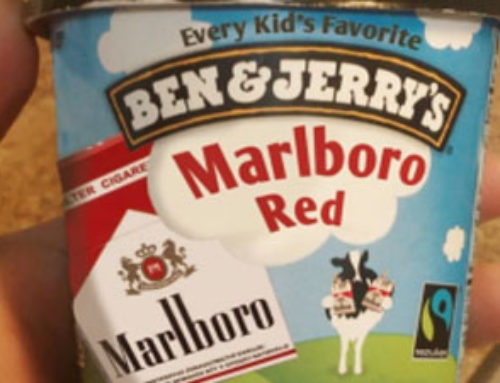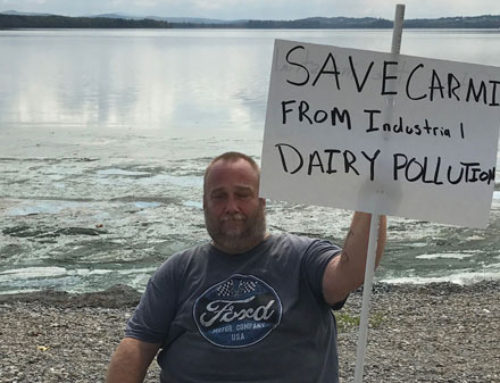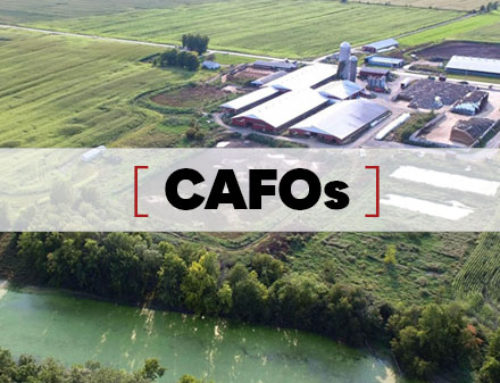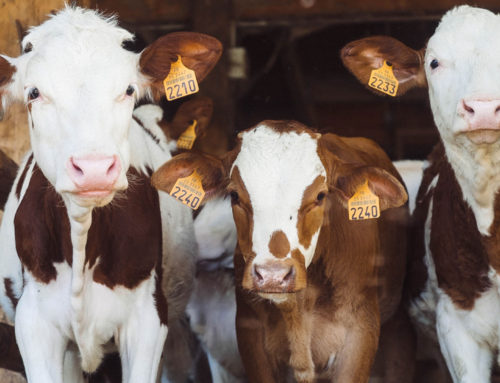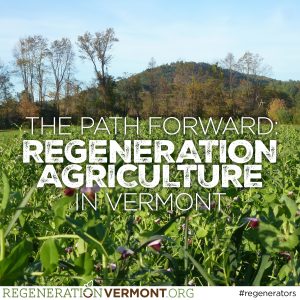
The battleground over industrial agriculture has, understandably, been centered around GMOs for the last two decades. In the U.S., the GMO debate has largely revolved around labeling, both nationally and, more successfully, on a state-by-state basis. Vermont, of course, was the first state to pass mandatory GMO labeling requirements, a law that takes effect in July 2016; if, that is, it passes the remaining legal and legislative challenges.
While the GMO labeling initiatives will continue to raise public awareness about the issue and put pressure on the food industry to respond and conform, Regeneration Vermont will pivot toward new strategies in the battle against GMOs and industrial agriculture in general: activism based in the media and the marketplace, but also in the legislature, that strives to remove GMOs from the food supply and reshape Vermont’s agriculture around regenerative strategies.
Agricultural regeneration must be rooted in the local, or regional since soils and climate are so varied (even within Vermont). Regeneration Vermont seeks to create an educational/activist approach that can be helpful to other regeneration organizations.
The regeneration of agriculture cannot happen without the regeneration of activism. The horrors of industrial agriculture are well documented, from pesticides to GMOs, and from contaminated watersheds to monopolization. Unfortunately, the general public is unaware of these practices, so the hue and cry about industrial farming has been weak. But now, at a time when climate change rightly stands at the center of every eco-based campaign, agriculture looms larger as both a target for its abundant eco-transgressions but also as the most important vehicle for climate remediation.
In Vermont, dairy farmers are paying the price of the failed CAFO/AFO experiment in up-and-down milk prices, and higher pesticide, seed, and fertilizer costs; and while we lament the trap they seem to be in, it is the public that is burdened with even greater costs from this failed dairy farming experiment. The confined dairy strategy in Vermont and other states has produced unsafe dairy products (from toxic pesticides and fertilizers), encouraged bad farming practices, caused significant damage to the environment, and increased pollution of our public lakes, rivers, streams, and drinking water.
It doesn’t have to be this way. About 200 of the 970 Vermont dairy farms have already adopted sophisticated organic rotational grazing systems, which enhance the quality of the forage, and sequester large amounts of carbon that can help reverse climate change. Vermont’s 200 organic dairy farms account for more than 20% of Vermont’s dairies, the highest percentage in the U.S. These farm leaders have realized the urgency in rejecting the failed confined dairy farming system that depends on toxic fertilizers and pesticides, pollutes our lakes and waterways, and contributes to global warming. Ironically, while there is a glut of CAFO and AFO milk that is being dumped, there is a projected long-term shortage of organic milk. So, regenerative dairy models and technical assistance programs already exist.
Vermont is blessed with abundant water, lush pastures, and an environment where pastured cows can thrive. All of Vermont’s dairies could adopt a more sustainable form of dairy management, and the government and private businesses could help farmers make the transition and curb the pollution. We have the technical knowledge to make these management changes, but we urgently need to accelerate the transition to cleaner, safer, and more environmentally friendly dairy farming systems. Recent research has illustrated that organic land management strategies (cover crops, no till, minimum till, and crop rotation) produce higher yields. An Organic Yield Enhancement and Carbon Sequestration program could help farmers make the transition to higher yields and be a good use of taxpayer subsidies.
The regeneration movement is focused on slowing down and ultimately ending greenhouse gas emissions from all GHG generating practices, but especially targeting both agriculture and urban gardening. Its parallel and equally important focus is on promoting strategies designed to bring the excess carbon in the atmosphere back to earth and sequestering those gasses in farm, ranch, and forest soils, where they are beneficial instead of harmful.
Regeneration International is in the process of building a movement that is designed to both research and illustrate how severe the GHG pollution from farming has become and illustrate how shovel-ready regenerative farming practices are being used all around the world—right now, even in our own communities. In other words, agriculture, in it’s current industrial model is the problem. BUT, on the other hand, we have a solution in regenerative, organic agriculture. And the good news is these methods are already at hand. The practices just need to be greatly expanded throughout the world.
Farm, ranch, and forest soils are currently deficient in carbon because of industrial and other inefficient land management practices. As a result, worldwide, soil carbon losses range from 50% to 70%. That makes these deficient farm and forest soils the most available sink for the excess carbon in the atmosphere and the oceans. How? Plant photosynthesis pulls carbon gasses out of the atmosphere and the oceans and uses them to feed soil microorganisms and plants.
By making changes in our agricultural and forestry practices we can pull more carbon out of the atmosphere and improve our soil fertility and help to reverse climate change. Most of our industrialized farmland in the US (and Vermont) lies bare for 8 months every year. Planting a cover crop, like our grandparents did, could triple the amount of sequestered carbon every year.
